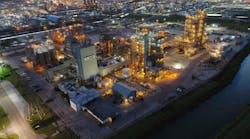Last month I described the decision process used to apply a Coriolis flowmeter application in gaseous ammonia service operating at a relatively low density (Flow Control, Aug. 2013, page 14). I had some apprehensions about using a Coriolis flowmeter in this application.
All of the published graphs for Coriolis flowmeters were for liquid service, so the manufacturer’s engineer was asked to size a Coriolis flowmeter for use in our 4-inch pipe. A 1-inch Coriolis flowmeter was suggested and (exercising one of my rules-of-thumb) was verified by the manufacturer as the correct size.
My rule-of-thumb is that sizing should be “checked, double-checked, and then checked again” when the size of a flowmeter is more than one size smaller than the piping in which it is installed. In this application, the flowmeter was four pipe sizes smaller—prompting my skepticism.
Satisfied that the sizing was correct, the 1-inch Coriolis flowmeter was installed between two spool-pieces, each consisting of a 4-inch flange that mated with the pipe flange, a 1-inch flange that mated with the flowmeter flange, and a short piece of 1-inch pipe welded to the two flanges.
The installation was performed in the early evening, so at about 8:00 pm plant personnel called to tell me that the flowmeter presented such a large obstruction that it would not pass (even close to) the operating flow—even when the operating pressure was increased substantially. I suggested that the Coriolis flowmeter be removed and the existing vortex shedding flowmeter be re-installed.
Strike one. More next month …
NEXT ARTICLE: Strike 2!—Specifying a Coriolis flowmeter for gas service
David W. Spitzer is a regular contributor to Flow Control magazine and a principal in Spitzer and Boyes, LLC offering engineering, seminars, strategic marketing consulting, distribution consulting and expert witness services for manufacturing and automation companies. He has more than 35 years of experience and has written over 10 books and 250 articles about flow measurement, instrumentation and process control.
Mr. Spitzer can be reached at 845 623-1830 or ?www.spitzerandboyes.com. Click on the “Products” tab to find his “Consumer Guides” to various flow and level measurement technologies.



